Growth Analysis of Pearl Millet Genotypes Grown Under Different Management Practices
Abstract
1. Introduction
2. Materials and Methods
2.1. Site Description and Treatment Design
2.2. Water Balance and Water Use Efficiency
2.3. Data Collection
3. Results
3.1. Temperature and Precipitation Data
3.2. Water Use
3.3. Soil Water Content (SWC) Variation
3.4. Growth Parameters
3.4.1. Plant Height
3.4.2. Number of Tillers
3.4.3. Stem Diameter
3.4.4. Leaf Area Index (LAI) and Light Interception
3.4.5. Panicle Number, Length, and Diameter
3.4.6. Flowering Date
3.4.7. Leaf-to-Stem Ratio (LSR)
3.4.8. Harvest Index
3.5. Final Yields
3.5.1. Grain Yield
3.5.2. Biomass Yields
3.5.3. Water Use Efficiency (WUE)
4. Discussion
5. Conclusions
Author Contributions
Funding
Data Availability Statement
Conflicts of Interest
References
- Fatondji, D.; Ajeigbe, H.A.; Ibrahim, A. Modern Crop Management Practices for Pearl Millet Cultivation in Semi-Arid Africa. In Pearl Millet in the 21st Century: Food-Nutrition-Climate Resilience-Improved Livelihoods; Springer: Berlin/Heidelberg, Germany, 2024; pp. 445–477. [Google Scholar]
- Ciampitti, I.A.; Perumal, R.; Prasad, P.V. Growth and Development of Pearl Millet. In Pearl Millet: A Resilient Cereal Crop for Food, Nutrition, and Climate Security; Wiley: Hoboken, NJ, USA, 2024; p. 225. [Google Scholar]
- Vetriventhan, M.; Yadav, O.P.; Srivastava, R.K.; Pandey, S.; Singhirrigation, K. Pearl Millet Germplasm Resources. In Pearl Millet: A Resilient Cereal Crop for Food, Nutrition, and Climate Security; Wiley: Hoboken, NJ, USA, 2024; pp. 23–52. [Google Scholar]
- Shrestha, N.; Hu, H.; Shrestha, K.; Doust, A.N. Pearl millet response to drought: A review. Frontiers in Plant Science 2023, 14, 1059574. [Google Scholar] [PubMed]
- Venkatesh, K.; Maruthamuthu, E.; Srividhya, S.; Nayak, S. Comprehending the Physiological Efficiency of Millets Under Abiotic Stress, in Translating Physiological Tools to Augment Crop Breeding; Springer: Berlin/Heidelberg, Germany, 2023; pp. 411–423. [Google Scholar]
- Ajeigbe, H.A.; Akinseye, F.M.; Kamara, A.Y.; Tukur, A.A.; Inuwa, A.H. Productivity, water-and nitrogen-use efficiency, and profitability of pearl millet (Pennisetum glaucum) under different nitrogen applications in semiarid region of Nigeria. Int. J. Agron. 2020, 2020, 1802460. [Google Scholar]
- Baligar, V.; Fageria, N.; He, Z. Nutrient use efficiency in plants. Commun. Soil Sci. Plant Anal. 2001, 32, 921–950. [Google Scholar]
- Fageria, N.; Baligar, V.; Li, Y. The role of nutrient efficient plants in improving crop yields in the twenty first century. J. Plant Nutr. 2008, 31, 1121–1157. [Google Scholar]
- Turner, N. Plant water relations and irrigation management. Agric. Water Manag. 1990, 17, 59–73. [Google Scholar]
- Yang, J.; Zhou, Q.; Zhang, J. Moderate wetting and drying increases rice yield and reduces water use, grain arsenic level, and methane emission. Crop J. 2017, 5, 151–158. [Google Scholar]
- Harlan, J.R. Our vanishing genetic resources. Science 1975, 188, 618–621. [Google Scholar]
- Marone, D.; Russo, M.A.; Mores, A.; Ficco, D.B.M.; Laidò, G.; Mastrangelo, A.M.; Borrelli, G.M. Importance of landraces in cereal breeding for stress tolerance. Plants 2021, 10, 1267. [Google Scholar] [CrossRef]
- Dwivedi, S.L.; Ceccarelli, S.; Blair, M.W.; Upadhyaya, H.D.; Are, A.K.; Ortiz, R. Landrace germplasm for improving yield and abiotic stress adaptation. Trends Plant Sci. 2016, 21, 31–42. [Google Scholar]
- Villa, T.C.C.; Maxted, N.; Scholten, M.; Ford-Lloyd, B. Defining and identifying crop landraces. Plant Genet. Resour. 2005, 3, 373–384. [Google Scholar]
- Kelley, T.; Rao, P.P.; Purohit, M. Adoption of improved cultivars of pearl millet in an arid environment: Straw yield and quality considerations in western Rajasthan. Exp. Agric. 1996, 32, 161–171. [Google Scholar]
- Srivastava, R.K.; Yadav, O.P.; Sivasakthi, K.; Gupta, S.K.; Desalegn, D.S.; Sunita, C.; Mahalingam, G.; Jana, K.; Tharanya, M.; Tara, S.C.; et al. Breeding drought-tolerant pearl millet using conventional and genomic approaches: Achievements and prospects. Front. Plant Sci. 2022, 13, 781524. [Google Scholar]
- Maman, N.; Mason, S.; Sirifi, S. Influence of variety and management level on pearl millet production in Niger. I. Grain yield and dry matter accumulation. Afr. Crop Sci. J. 2000, 8, 25–34. [Google Scholar]
- Payne, W.A. Managing yield and water use of pearl millet in the Sahel. Agron. J. 1997, 89, 481–490. [Google Scholar]
- Ficiciyan, A.; Loos, J.; Sievers-Glotzbach, S.; Tscharntke, T. More than yield: Ecosystem services of traditional versus modern crop varieties revisited. Sustainability 2018, 10, 2834. [Google Scholar] [CrossRef]
- Serba, D.D.; Yadav, R.S.; Varshney, R.K.; Gupta, S.K.; Mahalingam, G.; Srivastava, R.K.; Gupta, R. Genomic designing of pearl millet: A resilient crop for arid and semi-arid environments. In Genomic Designing of Climate—Smart Cereal Crops; Springer: Berlin/Heidelberg, Germany, 2020; pp. 221–286. [Google Scholar]
- Sood, V.; Sharma, V.; Dixit, S.P.; Verma, R.; Katna, G. Present status and revival of millets cultivation in Himachal Pradesh. Himachal J. Agric. Res. 2023, 49, 18–37. [Google Scholar]
- Jukanti, A.; Gowda, C.L.; Rai, K.N.; Manga, V.K.; Bhatt, R.K. Crops that feed the world 11. Pearl Millet (Pennisetum glaucum L.): An important source of food security, nutrition and health in the arid and semi-arid tropics. Food Secur. 2016, 8, 307–329. [Google Scholar]
- Awala, S.K.; Hove, K.; Valombola, J.S.; Nafuka, H.N.; Simasiku, E.K.; Chataika, B.; Horn, L.N.; Angombe, S.; Akundabweni, L.S.; Mwandemele, O.D.; et al. Co-Cultivation and Matching of Early-and Late-Maturing Pearl Millet Varieties to Sowing Windows Can Enhance Climate-Change Adaptation in Semi-Arid Sub-Saharan Agroecosystems. Climate 2023, 11, 227. [Google Scholar] [CrossRef]
- Djanaguiraman, M.; Priyanka, A.S.; Vaishnavi, S.J.; Perumal, R.; Ciampitti, I.A.; Prasad, P.V. Impact of Drought and High-temperature Stresses on Growth and Development Stages, Physiological, Reproductive, and Yield Traits on Pearl Millet. In Pearl Millet: A Resilient Cereal Crop for Food, Nutrition, and Climate Security; Wiley: Hoboken, NJ, USA, 2024; pp. 249–276. [Google Scholar]
- Ahmed, M.; Sanders, J.; Nell, W. New sorghum and millet cultivar introduction in Sub-Saharan Africa: Impacts and research agenda. Agric. Syst. 2000, 64, 55–65. [Google Scholar]
- Alvarez, J.F.O.; de Juan Valero, J.A.; Tarjuelo Martín-Benito, J.M.; López Mata, E. MOPECO: An economic optimization model for irrigation water management. Irrig. Sci. 2004, 23, 61–75. [Google Scholar]
- Navarro-Hellín, H.; Martinez-del-Rincon, J.; Domingo-Miguel, R.; Soto-Valles, F.; Torres-Sánchez, R. A decision support system for managing irrigation in agriculture. Comput. Electron. Agric. 2016, 124, 121–131. [Google Scholar] [CrossRef]
- Navarro-Hellín, H.; Torres-Sánchez, R.; Soto-Valles, F.; Albaladejo-Pérez, C.; López-Riquelme, J.A.; Domingo-Miguel, R. A wireless sensors architecture for efficient irrigation water management. Agric. Water Manag. 2015, 151, 64–74. [Google Scholar] [CrossRef]
- Khairwal, I.; Yadav, S.K.; Rai, K.N.; Upadhyaya, H.D.; Kachhawa, D.; Nirwan, B.; Bhattacharjee, R.; Rajpurohit, B.S.; Dangaria, C.J. Evaluation and identification of promising pearl millet germplasm for grain and fodder traits. J. SAT Agric. Res. 2007, 5, 1–6. [Google Scholar]
- Sedivec, K.K.; Schatz, B.G. Pearl Millet: Forage Production in North Dakota; North Dakota University Press: Fargo, ND, USA, 1991. [Google Scholar]
- Gulia, S.; Wilson, J.P.; Carter, J.; Singh, B.P. Progress in grain pearl millet research and market development. In Issues in New Crops and New Uses; ASHS Press: Alexandria, VA, USA, 2007; pp. 196–203. [Google Scholar]
- Velu, G.; Rai, K.N.; Muralidharan, V.; Kulkarni, V.N.; Longvah, T.; Raveendran, T.S. Prospects of breeding biofortified pearl millet with high grain iron and zinc content. Plant Breed. 2007, 126, 182–185. [Google Scholar] [CrossRef]
- Ram, B.; Chaudhary, G.R.; Jat, A.S.; Jat, M.L. Effect of integrated weed management and intercropping systems on growth and yield of pearlmillet (Pennisetum glaucum). Indian J. Agron. 2005, 50, 210–213. [Google Scholar]
- Pale, S.; Mason, S.C.; Galusha, T.D. Planting time for early-season pearl millet and grain sorghum in Nebraska. Agron. J. 2003, 95, 1047–1053. [Google Scholar] [CrossRef]
- Maman, N.; Lyon, D.J.; Mason, S.C.; Galusha, T.D.; Higgins, R. Pearl millet and grain sorghum yield response to water supply in Nebraska. Agron. J. 2003, 95, 1618–1624. [Google Scholar] [CrossRef]
- Alagarswamy, G.; Gardner, J.C.; Maranville, J.W.; Clark, R.B. Measurement of instantaneous nitrogen use efficiency among pearl millet genotypes. Crop Sci. 1988, 28, 681–685. [Google Scholar] [CrossRef]
- Prasad, S.; Samota, A.; Singh, M.K.; Verma, S.K. Cultivars and nitrogen levels influence on yield attributes, yield and protein content of pearl millet under semi-arid condition of vindhyan region. Ecoscan 2014, 6, 47–50. [Google Scholar]
- Egea, G.; González-Real, M.M.; Baille, A.; Nortes, P.A.; Sánchez-Bel, P.; Domingo, R. The effects of contrasted deficit irrigation strategies on the fruit growth and kernel quality of mature almond trees. Agric. Water Manag. 2009, 96, 1605–1614. [Google Scholar] [CrossRef]
- Jones, H.G. Irrigation scheduling: Advantages and pitfalls of plant-based methods. J. Exp. Bot. 2004, 55, 2427–2436. [Google Scholar] [CrossRef]
- Puerto, P.; Domingo, R.; Torres, R.; Pérez-Pastor, A.; García-Riquelme, M. Remote management of deficit irrigation in almond trees based on maximum daily trunk shrinkage. Water relations and yield. Agric. Water Manag. 2013, 126, 33–45. [Google Scholar]
- Ausiku, A.P.; Annandale, J.G.; Steyn, J.M.; Sanewe, A.J. Improving Pearl Millet (Pennisetum glaucum) Productivity through Adaptive Management of Water and Nitrogen. Water 2020, 12, 422. [Google Scholar] [CrossRef]
- Ghatak, A.; Chaturvedi, P.; Bachmann, G.; Valledor, L.; Ramšak, Ž.; Bazargani, M.M.; Bajaj, P.; Jegadeesan, S.; Li, W.; Sun, X.; et al. Physiological and proteomic signatures reveal mechanisms of superior drought resilience in pearl millet compared to wheat. Front. Plant Sci. 2021, 11, 600278. [Google Scholar]
- Yadav, O.; Bidinger, F. Dual-purpose landraces of pearl millet (Pennisetum glaucum) as sources of high stover and grain yield for arid zone environments. Plant Genet. Resour. 2008, 6, 73–78. [Google Scholar] [CrossRef]
- Annandale, J.; Campbell, G.S.; Olivier, F.C.; Jovanovic, N.Z. Predicting crop water uptake under full and deficit irrigation: An example using pea (Pisum sativum L. cv. Puget). Irrig. Sci. 2000, 19, 65–72. [Google Scholar] [CrossRef]
- Zhang, G.; Liu, C.; Xiao, C.; Xie, R.; Ming, B.; Hou, P.; Liu, G.; Xu, W.; Shen, D.; Wang, K.; et al. Optimizing water use efficiency and economic return of super high yield spring maize under drip irrigation and plastic mulching in arid areas of China. Field Crops Res. 2017, 211, 137–146. [Google Scholar]
- Kresović, B.; Tapanarova, A.; Tomić, Z.; Životić, L.; Vujović, D.; Sredojević, Z.; Gajić, B. Grain yield and water use efficiency of maize as influenced by different irrigation regimes through sprinkler irrigation under temperate climate. Agric. Water Manag. 2016, 169, 34–43. [Google Scholar]
- Tari, A.F. The effects of different deficit irrigation strategies on yield, quality, and water-use efficiencies of wheat under semi-arid conditions. Agric. Water Manag. 2016, 167, 1–10. [Google Scholar]
- Fang, H.; Li, Y.; Gu, X.; Du, Y.; Chen, P.; Hu, H. Evapotranspiration, water use efficiency, and yield for film mulched maize under different nitrogen-fertilization rates and climate conditions. Agric. Water Manag. 2024, 301, 108935. [Google Scholar]
- Liu, M.; Liang, F.; Li, Q.; Wang, G.; Tian, Y.; Jia, H. Enhancement growth, water use efficiency and economic benefit for maize by drip irrigation in Northwest China. Sci. Rep. 2023, 13, 8392. [Google Scholar] [CrossRef] [PubMed]
- Anderson, R.L. Experimental Design: Theory and Application; JSTOR: New York, NY, USA, 1956. [Google Scholar]
- Huynh, H.; Feldt, L.S. Estimation of the Box correction for degrees of freedom from sample data in randomized block and split-plot designs. J. Educ. Stat. 1976, 1, 69–82. [Google Scholar] [CrossRef]
- Bailer, A.J. Statistical Programming in SAS; Chapman and Hall/CRC: Boca Raton, FL, USA, 2020. [Google Scholar]
- Ong, C.; Monteith, J. Response of pearl millet to light and temperature. Field Crops Res. 1985, 11, 141–160. [Google Scholar] [CrossRef]
- Naeem, M.; Tahir, M.; Ibrahim, M.; Aslam, M.N. Study of green fodder yield potential and its components of different pearl millet (Pennisetum americanum) varieties under irrigated conditions of Faisalabad [Pakistan]. Asian J. Plant Sci. 2003, 2. [Google Scholar] [CrossRef]
- Ayub, M.; Nadeem, M.A.; Tahir, M.; Ibrahim, M.; Aslam, M.N. Effect of nitrogen application and harvesting intervals on forage yield and quality of pearl millet (Pennisetum americanum L.). Pak. J. Life Soc. Sci 2009, 7, 185–189. [Google Scholar]
- Bukhari, M. Effect of Different Harvesting Intervals on Growth, Forage Yield and Quality of Pearl Millet (Pennisetum americanum L.) Cultivars. Master’s Thesies, Faisalabad University of Agriculture, Faisalabad, Pakistan, 2009. [Google Scholar]
- Shao, H.-B.; Chu, L.Y.; Lu, Z.H.; Kang, C.M. Primary antioxidant free radical scavenging and redox signaling pathways in higher plant cells. Int. J. Biol. Sci. 2008, 4, 8. [Google Scholar] [CrossRef]
- Ludlow, M.; Muchow, R. A critical evaluation of traits for improving crop yields in water-limited environments. In Advances in Agronomy; Elsevier: Amsterdam, The Netherlands, 1990; pp. 107–153. [Google Scholar]
- Mahalakshmi, V.; Bidinger, F. Flowering response of pearl millet to water stress during panicle development. Ann. Appl. Biol. 1985, 106, 571–578. [Google Scholar] [CrossRef]
- Millet, E.; Feldman, M. Yield response of a common spring wheat cultivar to inoculation with Azospirillum brasilense at various levels of nitrogen fertilization. Plant Soil 1984, 80, 255–259. [Google Scholar]
- Seghatoleslami, M.; Kafi, M.; Majidi, E. Effect of drought stress at different growth stages on yield and water use efficiency of five proso millet (Panicum miliaceum L.) genotypes. Pak. J. Bot. 2008, 40, 1427–1432. [Google Scholar]
- Sowjanya, A.; Rao, C.P.; Rao, C.S. Response of Phosphorus on Growth and Yield of Pearl Millet, Microbial Population and System Productivity in Pearl Millet Based Cropping Systems. J. Exp. Agric. Int. 2021, 113–124. [Google Scholar] [CrossRef]
- Singh, B.; Singh, D. Agronomic and physiological responses of sorghum, maize and pearl millet to irrigation. Field Crops Res. 1995, 42, 57–67. [Google Scholar] [CrossRef]
- Shanmuganathan, M.; AGopalan; Mohanraj, K. Genetic variability and multivariate analysis in pearl millet (Pennisetum glaucum (L.) R. Br.) germplasm for dual purpose. J. Agric. Sci. 2006, 2, 74–75. [Google Scholar] [CrossRef][Green Version]
- Hassanat, F.; Mustafa, A.F.; Seguin, P. Effect of the brown midrib trait and stage of development at harvest on cell wall composition and degradability of forage pearl millet leaves and stems. Can. J. Anim. Sci. 2007, 87, 421–429. [Google Scholar] [CrossRef]
- Bidinger, F.R.; Hash, C.T. Pearl millet. In Physiology and Biotechnology Integration for Plant Breeding; Marcel Dekker: New York, NY, USA, 2004; pp. 225–270. [Google Scholar]
- Nagaz, K.; MMasmoudi; Mechila, N. Yield and water use-efficiency of pearl millet (Pennisetum glaucum (L.) R. Br.) under deficit irrigation with saline water in arid conditions of Southern Tunisia. Res. J. Agron. 2009, 3, 9–17. [Google Scholar]
- Yadav, R.; Bidinger, F.; Hash, C.; Yadav, Y.; Yadav, O.; Bhatnagar, S.; Howarth, C. Mapping and characterisation of QTL× E interactions for traits determining grain and stover yield in pearl millet. Theor. Appl. Genet. 2003, 106, 512–520. [Google Scholar] [CrossRef]
- Barbieri, P.; Echarte, L.; Della Maggiora, A.; Sadras, V.O.; Echeverría, H.; Andrade, F.H. Maize evapotranspiration and water-use efficiency in response to row spacing. Agron. J. 2012, 104, 939–944. [Google Scholar] [CrossRef]
- Mdemu, M.; Kissoly, L.; Bjornlund, H.; Kimaro, E.; Christen, E.W.; van Rooyen, A.; Stirzaker, R.; Ramshaw, P. The role of soil water monitoring tools and agricultural innovation platforms in improving food security and income of farmers in smallholder irrigation schemes in Tanzania. Int. J. Water Resour.Dev. 2020, 36 (Suppl. S1), S148–S170. [Google Scholar] [CrossRef]
- Obeng, E.; Cebert, E.; Singh, B.P.; Ward, R.; Nyochembeng, L.M.; Mays, D.A. Growth and grain yield of pearl millet (Pennisetum glaucum) genotypes at different levels of nitrogen fertilization in the southeastern United States. J. Agric. Sci. 2012, 4, 155. [Google Scholar] [CrossRef][Green Version]
- Saifullah, A.; Munsif, F.; Arif, M.; Khan, H.; Ali, K.; Waqas, M.; Ali, A. Performance of millet varieties under different irrigation levels. Sarhad J. Agric. 2011, 27, 1–6. [Google Scholar]
- Yadav, A.K.; Kumar, A.; Singh, J.; Jat, R.D.; Jat, H.S.; Datta, A.; Singh, K.; Chaudhary, R. Performance of pearl millet genotypes under irrigated and rainfed conditions at Hisar, India. J. Appl. Nat. Sci. 2014, 6, 377–382. [Google Scholar]
- Naeem, M.; Khan, M.A.; Chohan, M.S.M.; Khan, A.H.; Salah-ud-Din, S. Evaluation of different varieties of pearl millet for green fodder yield potential. Asian J. Plant Sci. 2002, 1, 326–327. [Google Scholar] [CrossRef]
- Yusuf, M.J.; Nabi, G.; Basit, A.; Husnain, S.K.; Akhtar, L.H. Development of high yielding millet variety “Sargodha Bajra-2011” released for general cultivation in Punjab Province of Pakistan. Pak. J. Agric. Sci. 2012, 49, 299–305. [Google Scholar]
- Khan, A.; Naeem, N.; Muhammad, M.; Chohan, S.M.; Kainth, R.A. Fodder yield potential of pearl millet cultivars under irrigated conditions. Int. J. Agric. Biol. 2004, 6, 749–750. [Google Scholar]
- Welbank, P.; French, S.; Witts, K. Dependence of yields of wheat varieties on their leaf area durations. Ann. Bot. 1966, 30, 291–299. [Google Scholar]
- Pallavi, C.; Joseph, B.; Aariff Khan, B.A.; Hemalatha, S. Physiological Parameters, Leaf Nitrogen Content and Grain Yield of Finger Millet as Affected by Different Sources of Organic Manures under INM in Comparison with RDF. Int. J. Curr. Res. Biosci. Plant Biol. 2016, 3, 123–130. [Google Scholar]
- Pudelko, J.; Dwright, L.; Teare, I.D. A Method for Salvaging Bird Damaged Pearl Millet Research; North Florida Research and Education Center: Quincy FL, USA, 1993. [Google Scholar]
- Yadav, R.S.; Hash, C.T.; Bidinger, F.R.; Cavan, G.P.; Howarth, C.J. Quantitative trait loci associated with traits determining grain and stover yield in pearl millet under terminal drought-stress conditions. Theor. Appl. Genet. 2002, 104, 67–83. [Google Scholar]
- Reddy, B.; Reddy, P.S.; Bidinger, F.; Blümmel, M. Crop management factors influencing yield and quality of crop residues. Field Crops Res. 2003, 84, 57–77. [Google Scholar]
- Wilson, J.; Hatfield, R. Structural and chemical changes of cell wall types during stem development: Consequences for fibre degradation by rumen microflora. Aust. J. Agric. Res. 1997, 48, 165–180. [Google Scholar]
- Pasternak, D.; Ibrahim, A.; Augustine, A. Evaluation of five pearl millet varieties for yield and forage quality under two planting densities in the Sahel. Afr. J. Agric. Res. 2012, 7, 4526–4535. [Google Scholar]
- Burton, G.W.; Primo, A.; Lowrey, R. Effect of Clipping Frequency and Maturity on the Yield and Quality of Four Pearl Millets 1. Crop Sci. 1986, 26, 79–81. [Google Scholar]
- Radhouane, L. Evaluation of indices for identification of pearl millet ecotypes (Pennisetum glaucum) adapted to stress and no stress conditions. Sci. Int. 2013, 1, 64–69. [Google Scholar]
- Ullah, A.; Ahmad, A.; Khaliq, T.; Akhtar, J. Recognizing production options for pearl millet in Pakistan under changing climate scenarios. J. Integr. Agric. 2017, 16, 762–773. [Google Scholar]
- Bidinger, F.; Mahalakshmi, V.; Rao, G.D.P. Assessment of drought resistance in pearl millet (Pennisetum americanum (L.) Leeke). II. Estimation of genotype response to stress. Aust. J. Agric. Res. 1987, 38, 49–59. [Google Scholar]
- Yadav, O. Genetic divergence in pearl millet accessions of Indian and exotic origin. Indian J. Genet. 1994, 54, 89–93. [Google Scholar]
- Yadav, O.; Bhatnagar, S. Evaluation of indices for identification of pearl millet cultivars adapted to stress and non-stress conditions. Field Crops Res. 2001, 70, 201–208. [Google Scholar]
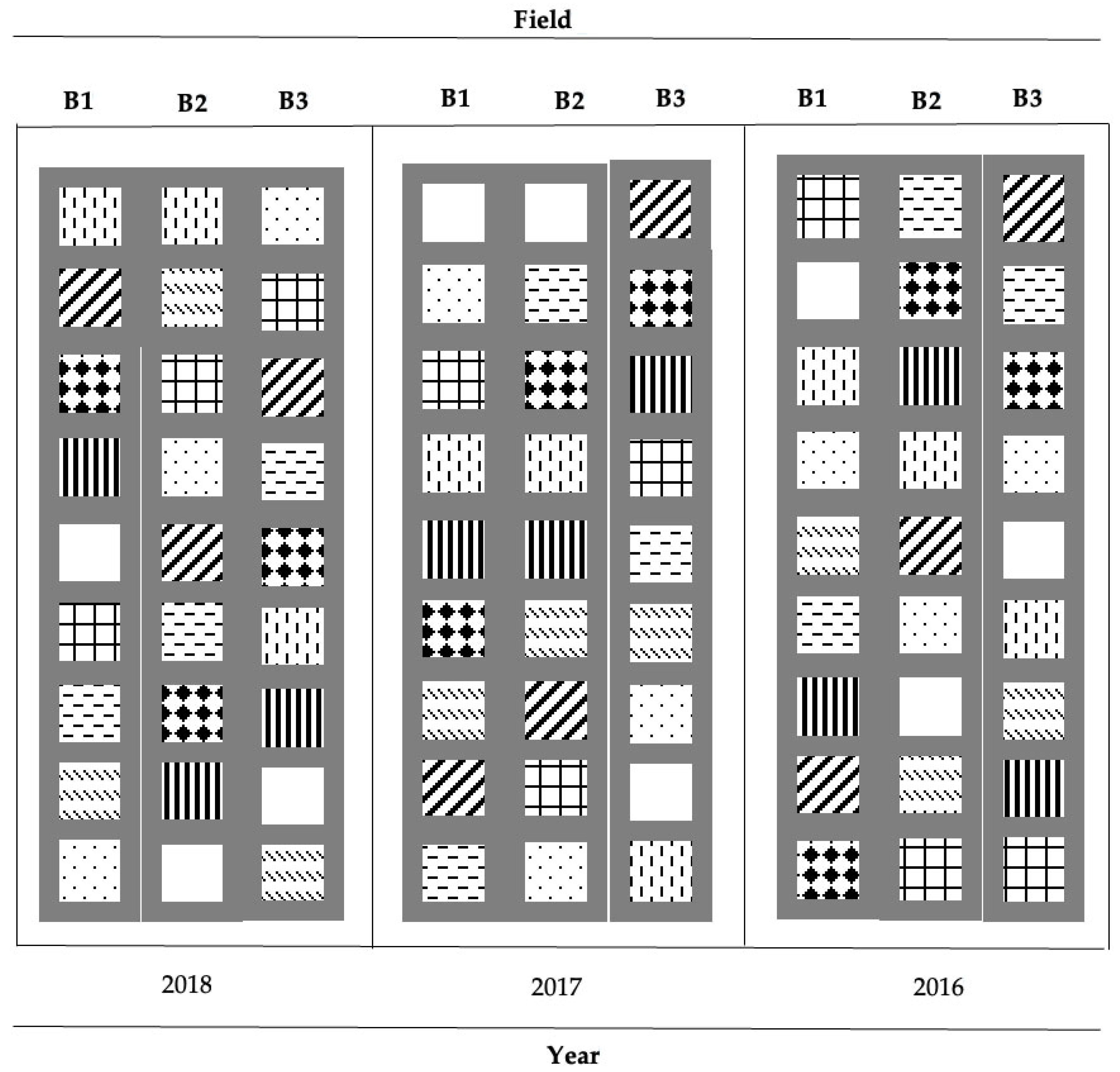
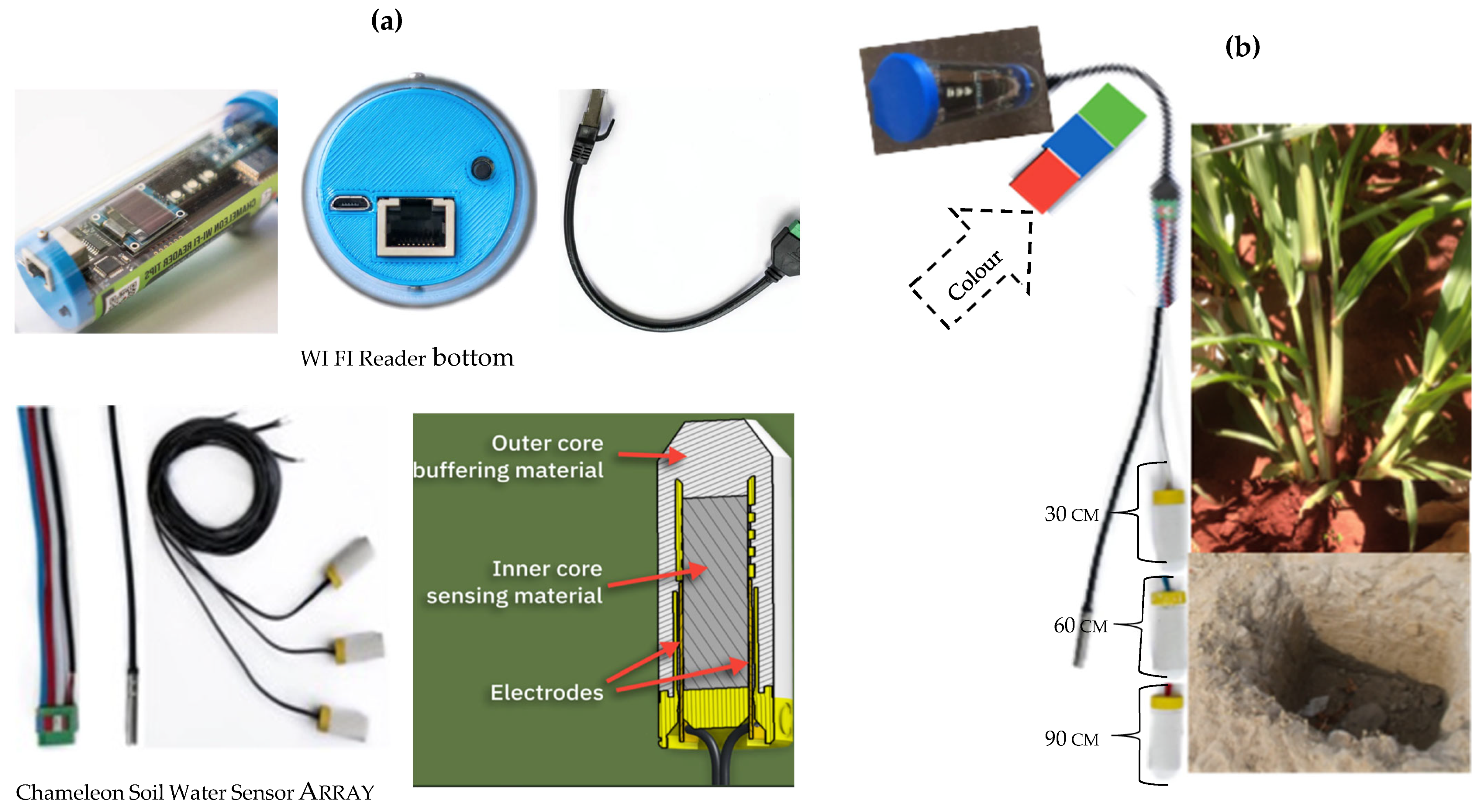
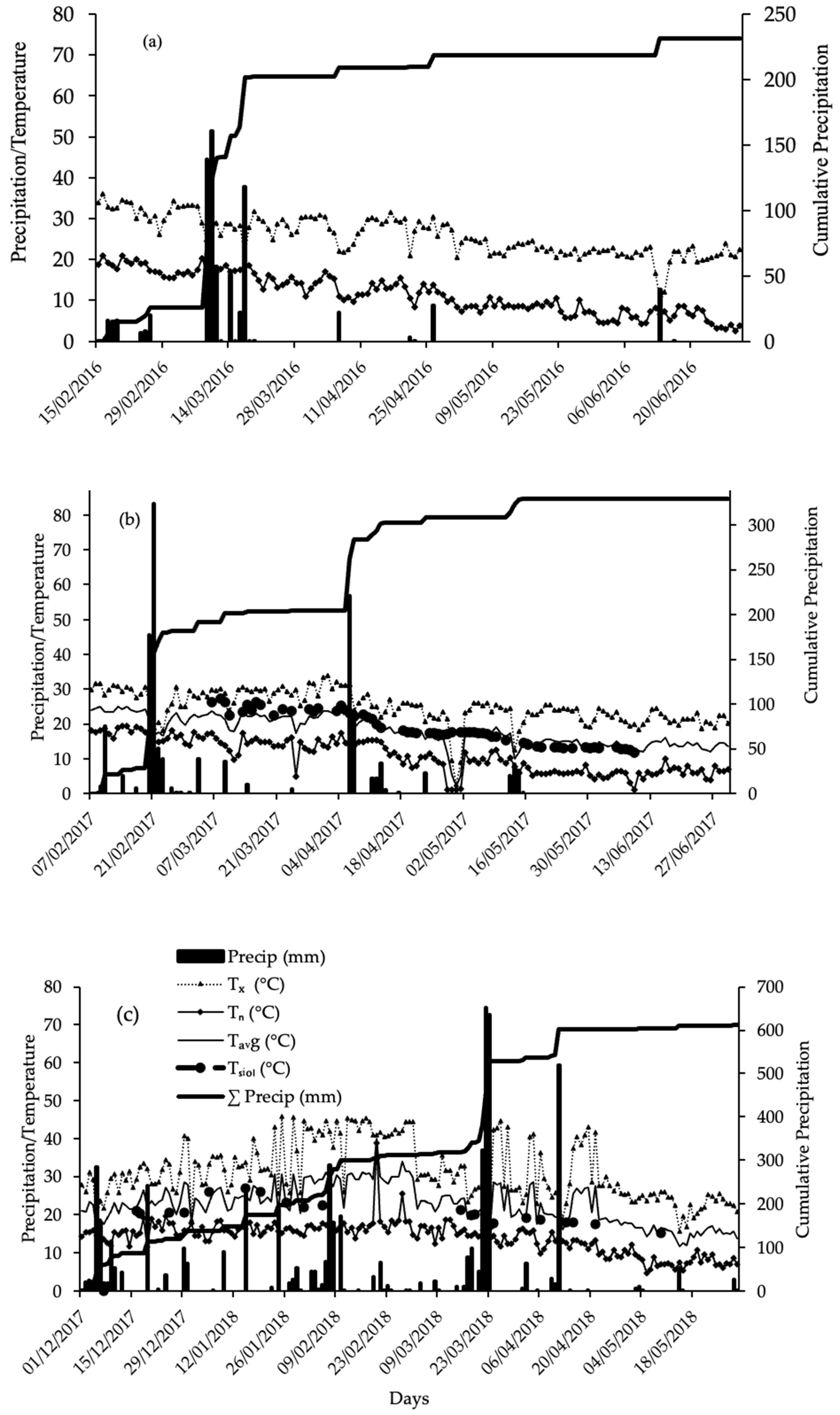
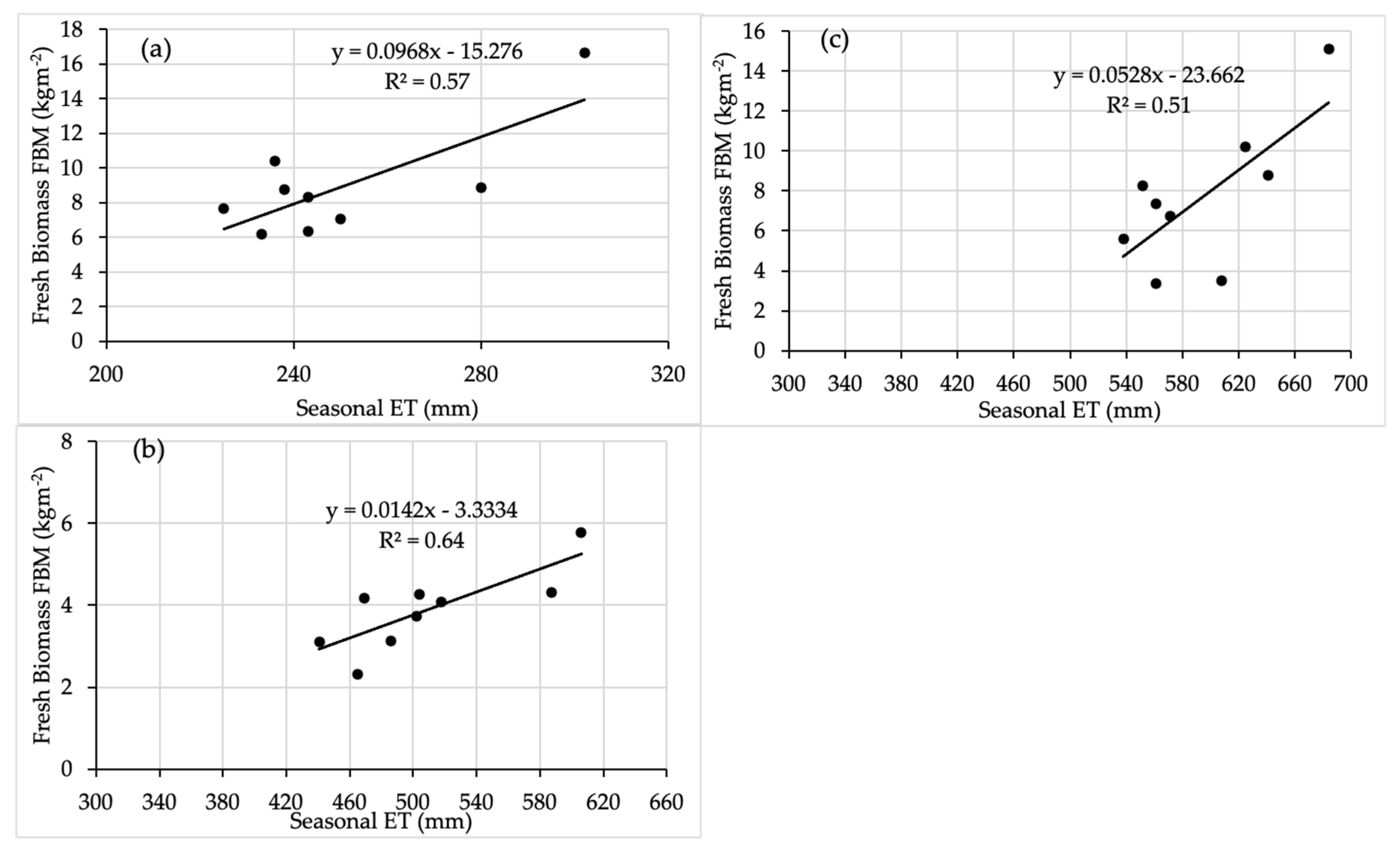
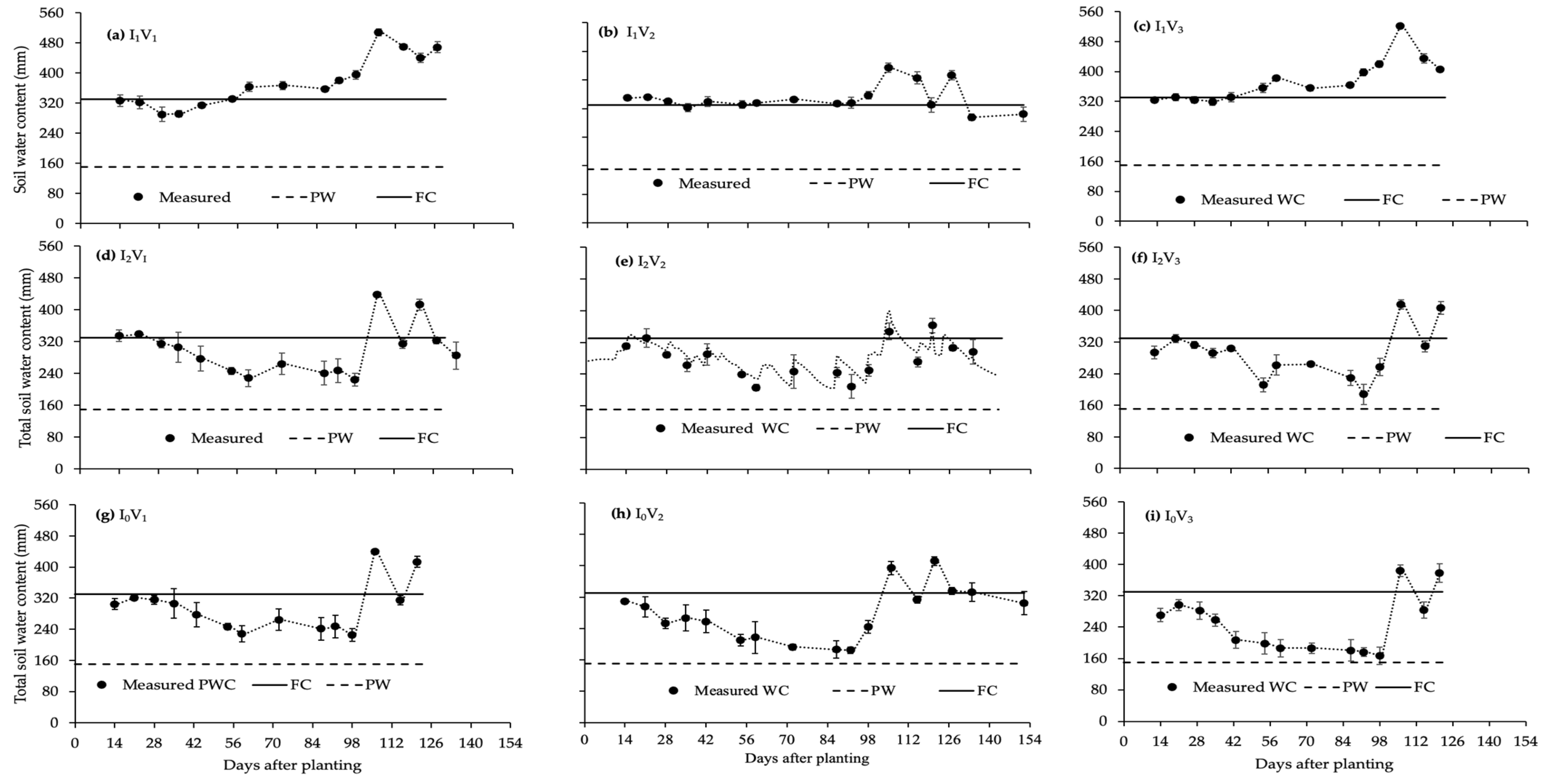
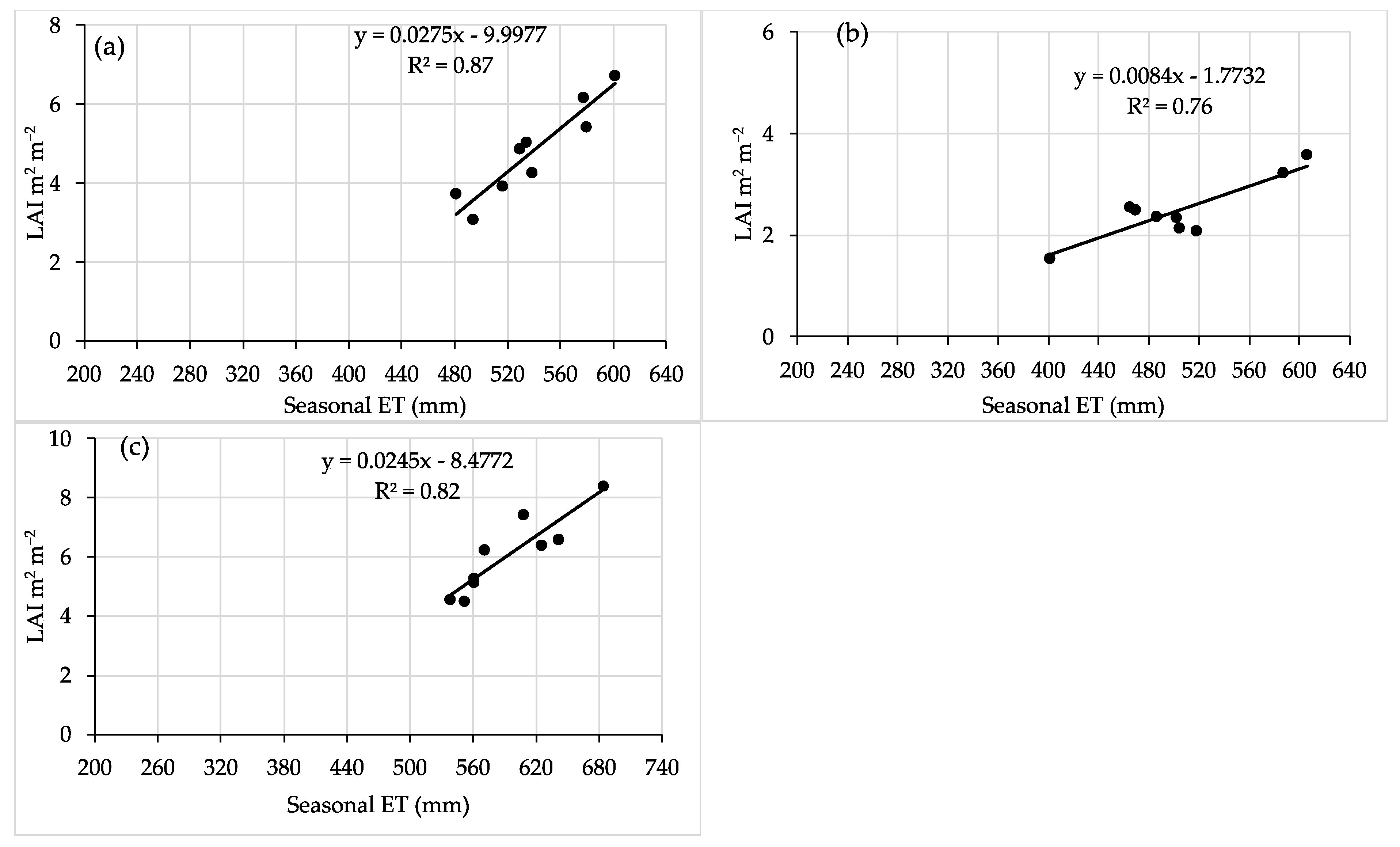
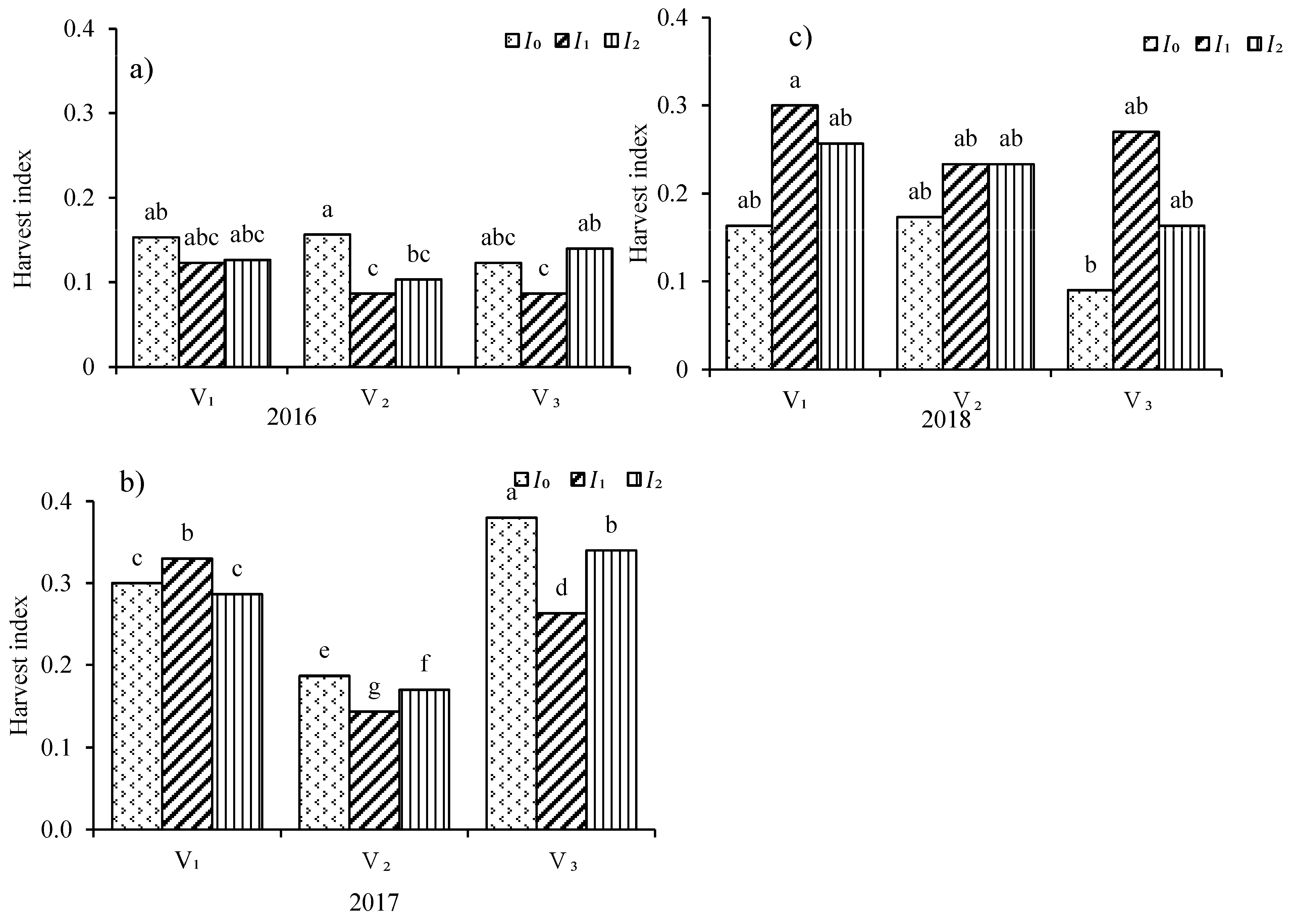
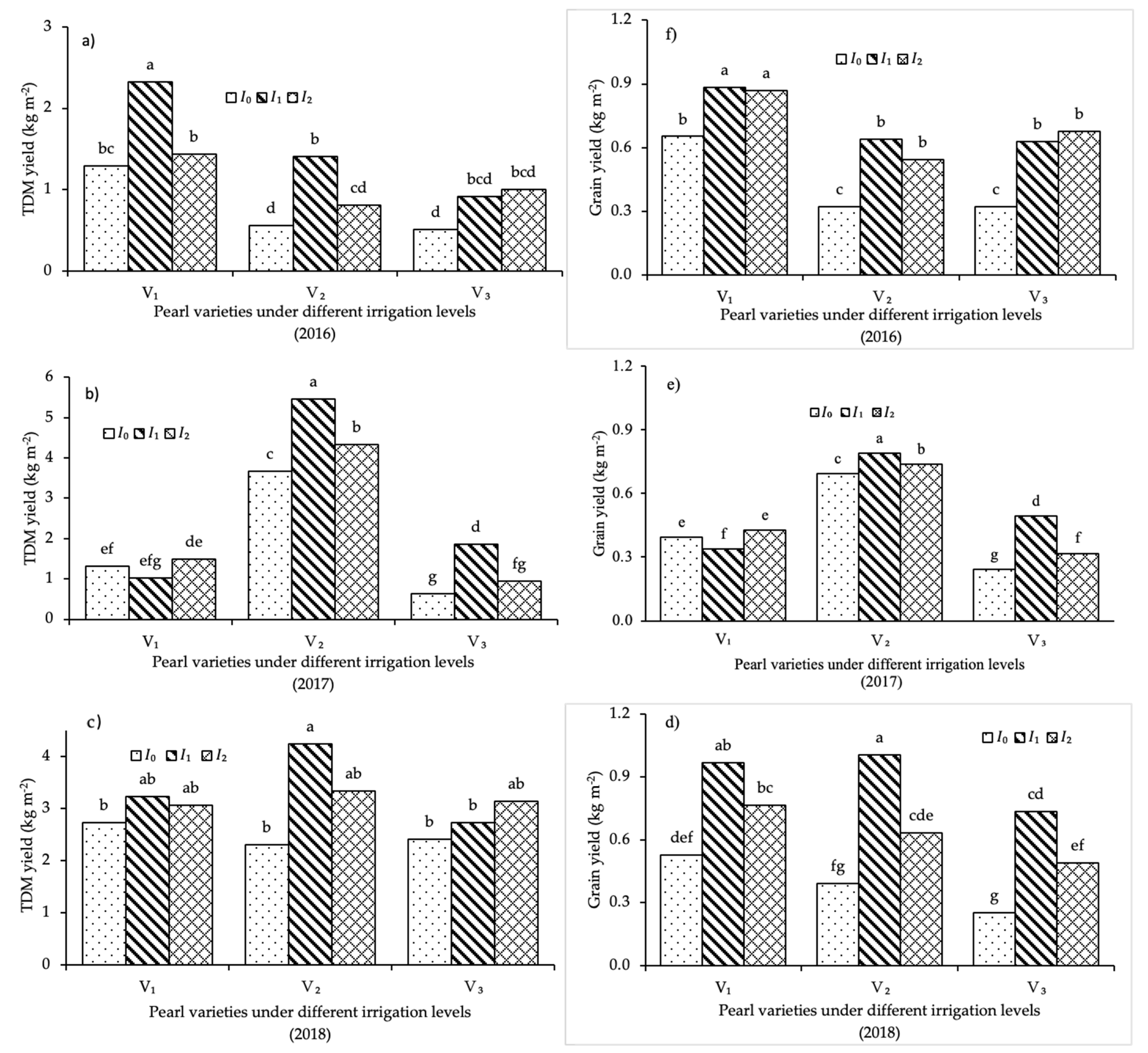

| 2016 | 2017 | 2018 | ||||||||
|---|---|---|---|---|---|---|---|---|---|---|
| 0–0.4 | 0.4–0.6 | 0.6–1.0 | 0–0.4 | 0.4–0.6 | 0.6–1.0 | 0–0.4 | 0.4–0.6 | 0.6–1.0 | ||
| Soil Properties | Unit | Physical Properties | ||||||||
| Clay | % | 22 | 30 | 32 | 24 | 32 | 33 | 16 | 26 | 27 |
| Silt | % | 21 | 24 | 26 | 23 | 20 | 23 | 19 | 17 | 18 |
| Sand | % | 57 | 46 | 42 | 53 | 48 | 44 | 65 | 57 | 55 |
| Texture | Sandy clay loam | Sandy clay loam | Clay loam | Sandy clay loam | Sandy clay loam | Clay loam | Sandy loam | Sandy clay loam | Loam | |
| Bulk Density | kg m−3 | 1251.10 (15.38) | 1200.18 (47.38) | 1232.40 (83.75) | 1235.95 (54.79) | 1127.10 (6.22) | 1442.84 (85.69) | 1283.70 (20.39) | 1261.41(51.40) | 1577.05 (86.15) |
| Field Capacity | m3m−3 | 0.30 | 0.34 | 0.36 | 0.31 | 0.33 | 0.35 | 0.27 | 0.30 | 0.31 |
| Permanent Wilting Point | m3m−3 | 0.18 | 0.22 | 0.24 | 0.19 | 0.21 | 0.23 | 0.15 | 0.18 | 0.19 |
| Chemical Properties | ||||||||||
| pH (H2O 1:1) | 6.80 (0.20) | 6.70 (0.42) | 6.84 (0.35) | 6.76 (0.35) | 6.86 (0.36) | 6.91 (0.15) | ||||
| N availabls | kg m−2 | 0.0038 (0.0006) | 0.035 (0.007) | 0.0043 (0.0004) | 0.0033 (0.0007) | 0.0042 (0.0002) | 0.003 (0.0011) | |||
| CEC | ME 100g−1 | 13.06 (2.58) | 14.89 (2.69) | 13.05 (3.65) | 15.66 (3.02) | 10.97 (1.35) | 14.11 (2.94) | |||
| Basa Saturation | ||||||||||
| Ca2+ | % | 63.06 (2.83) | 56.34 (2.68) | 61.98 (2.33) | 58.12 (0.0007) | 60.35 (5.27) | 59.14 (1.22) | |||
| Mg2+ | 24.09 (1.89) | 26.58 (2.95) | 23.47 (3.31) | 25.31 (1.43) | 24.75 (0.89) | 27.40 (3.22) | ||||
| K+ | 5.74 (2.34) | 6.07 ((0.98) | 6.03 (1.33) | 6.52 (2.27) | 6.29 (3.05) | 6.31 (2.31) | ||||
| Na+ | 0.92 (0.13) | 0.91 (0.21) | 0.91 (0.18) | 0.79 (0.031) | 0.97 (0.06) | 0.88 (0.14) | ||||
| H+ | 2.58 (1.23) | 9.00 (3.82) | 4.09 (0.90) | 9.23 (3.98) | 4.65 (1.67) | 2.66 (0.69) | ||||
| Other | 4.47 (0.14) | 4.70 (0.42) | 4.56 (0.35) | 4.64 (0.35) | 4.54 (0.36) | 4.49 (0.15) | ||||
| Organic Matter | % | 0.84 (0.14) | 0.79 (0.15) | 0.98 (0.13) | 0.75 (0.16) | 0.93 (0.03) | 0.67 (0.26) | |||
| NH4+ | mg kg−1 | 6.10 (0.73) | 4.68 (1.60) | 9.23 (1.09) | 3.53 (0.54) | 5.26 (1.13) | 4.03 (0.88) | |||
| NO3− | mg kg−1 | 1.83 (0.86) | 2.17 (1.21) | 3.06 (1.05) | 3.91 (0.82) | 1.26 (0.22) | 1.85 (1.50) | |||
| P | mg kg−1 | 61.23 (6.01) | 12.11 (3.29) | 76.17 (27.71) | 15.30 (16.49) | 50.70 (12.67) | 11.95 (1.98) | |||
| K | mg kg−1 | 271.97 (77.61) | 359.36 (107.92) | 256.30 (78.74) | 347.59 (83.46) | 392.04 (5.04) | 400.02 (13.37) | |||
| Ca | mg kg−1 | 1661.00 (402.94) | 1674.12 (275.27) | 1413.23 (81.66) | 1928.69 (201.32) | 1332.77 (283.89) | 1666.34 (329.66) | |||
| Mg | mg kg−1 | 378.21 (45.75) | 477.84 (61.87) | 342.14 (10.12) | 528.28 (32.27) | 330.39 (32.35) | 458.08 (68.95) | |||
| Fe | mg kg−1 | 139.29 (27.14) | 185.16 (61.87) | 166.62 (2.97) | 208.55 (38.34) | 171.28 (21.87) | 149.08 (21.34) | |||
| Mn | mg kg−1 | 53.53 (10.41) | 36.86 (9.14) | 46.36 (3.36) | 30.97 (6.92) | 55.76 (3.93) | 26.37 (2.33) | |||
| Cu | mg kg−1 | 2.78 (0.37) | 2.83 (0.26) | 2.92 (0.17) | 2.89 (0.20) | 2.77 (0.18) | 2.59 (0.11) | |||
| Zn | mg kg−1 | 3.10 (0.40) | 2.83 (1.01) | 2.51 (0.40) | 4.69 (0.90) | 3.48 (1.23) | 1.92 (0.98) | |||
| S | mg kg−1 | 10.34 (2.46) | 11.79 (1.79) | 15.06 (4.89) | 12.65 (0.68) | 8.22 (2.72) | 8.05 (0.75) | |||
| B | mg kg−1 | 0.51 (0.05) | 0.46 (0.04) | 0.49 (0.02) | 0.53 (0.03) | 0.51 (0.12) | 0.47 (0.09) | |||
| Treatments | Seasonal Precipitation (mm) | Seasonal Evapotranspiration, ET (mm) | Seasonal Irrigation (mm) | ||||||
|---|---|---|---|---|---|---|---|---|---|
| 2016 | 2017 | 2018 | 2016 | 2017 | 2018 | 2016 | 2017 | 2018 | |
| V1I0 | 255 | 316 | 469 | 481 | 469 | 561 | 38 | 0 | 0 |
| V2I0 | 255 | 316 | 470 | 529 | 518 | 608 | 38 | 0 | 0 |
| V3I0 | 255 | 316 | 468 | 494 | 401 | 538 | 38 | 0 | 0 |
| V1I1 | 255 | 316 | 469 | 577 | 504 | 625 | 88 | 115 | 87 |
| V2I1 | 255 | 316 | 470 | 601 | 606 | 684 | 94 | 115 | 85 |
| V3I1 | 255 | 316 | 468 | 534 | 486 | 571 | 94 | 115 | 74 |
| V1I2 | 255 | 316 | 469 | 538 | 502 | 561 | 67 | 41 | 50 |
| V2I2 | 255 | 316 | 470 | 579 | 587 | 641 | 67 | 56 | 50 |
| V3I2 | 255 | 316 | 468 | 516 | 465 | 552 | 67 | 41 | 49 |
| Source | df | Mean Square 2016 | ||||||||
|---|---|---|---|---|---|---|---|---|---|---|
| PH | ET | FI | PN | TN | FD | SD | PL | PD | ||
| Replication | 2 | 0.035 ns | 0.000 ns | 0.0036 ns | 33.00 ns | 6533.33 ns | 0.16 ns | 0.000047 ns | ||
| Cultivar (C) | 2 | 0.015 * | 20,678 *** | 0.018 *** | 1512 *** | 13,824 *** | 76.4 *** | 0.0055 *** | ||
| Irrigation (I) | 2 | 0.010 * | 254 *** | 0.092 *** | 4572 *** | 42,744 *** | 23.4 *** | 0.0041 *** | ||
| C × I | 4 | 0.017 ns | 0.000 ns | 0.066 ns | 249 *** | 1215 ns | 3.11 *** | 0.0040 ** | ||
| Error | 16 | 0.010 | 0.000 ns | 0.0029 | 249 | 2458 | 0.00011 | |||
| Total | 26 | |||||||||
| 2017 | ||||||||||
| Replication | 2 | 0.096 ns | 0.000 ns | 0.0009 ns | 2.09 ns | 36.37 ns | 0.15 ns | 0.0001 ns | 0.19 ns | |
| Cultivar (C) | 2 | 0.16 ** | 4170.3 *** | 0.047 *** | 721 *** | 600.55 ns | 158.4 *** | 00.001 *** | 1.28 ns | |
| Irrigation (I) | 8 | 0.79 *** | 9002.3 *** | 0.079 *** | 6244 *** | 8117.57 ns | 96.34 *** | 0.001 *** | 2.53 ** | |
| C × I | 7 | 0.036 ns | 0.000 ns | 0.004 *** | 630 *** | 251.04 ns | 23.42 *** | 0.001 *** | 5.53 *** | |
| Error | 16 | 0.020 | 0.000 ns | 0.0001 | 8.61 | 4.08 | 3.86 | 0.00005 | 0.46 | |
| Total | 26 | |||||||||
| 2018 | ||||||||||
| Replication | 2 | 0.0075 ns | 0.000 ns | 0.0026 ns | 38.04 ns | 3.5 ns | 0.44 ns | 0.0004 ns | 0.0001 ns | 0.19 ns |
| Cultivar (C) | 8 | 1.38 *** | 791.67 *** | 0.0037 ns | 4737 *** | 486 *** | 403.8 *** | 0.0034 * | 00.001 *** | 1.28 ns |
| Irrigation (I) | 2 | 0.34 ns | 136,401 *** | 0.0086 ns | 167 ** | 920 *** | 272.1 ** | 0.0012 ns | 0.001 *** | 2.53 ** |
| C × I | 7 | 0.69 ns | 0.000 ns | 0.0021 ns | 513 *** | 227.4 ** | 0.0008 ns | 0.001 *** | 5.53 *** | |
| Error | 16 | 0.480 | 0.000 ns | 0.0053 | 167.37 | 6.9 | 37.03 | 0.0009 | 0.00005 | 0.46 |
| Total | 26 | |||||||||
| PH (m) | FI | PN (m2) | TN (m2) | FD (DAP) | SD (m) | PL (m) | PD (m) | |
|---|---|---|---|---|---|---|---|---|
| Treatment 2016 | ||||||||
| I0V1 | 1.61 ab | 0.78 a | 36 c | 193 c | 52 c | 0.16 ef | ||
| I0V2 | 1.72 ab | 0.63 b | 54 bc | 195 c | 54 b | 0.21 bc | ||
| I0V3 | 1.58 ab | 0.65 b | 59 bc | 213 c | 52 d | 0.15 f | ||
| I1V1 | 1.68 ab | 0.88 a | 50 bc | 240 bc | 52 c | 0.19 cd | ||
| I1V2 | 1.82 a | 0.88 a | 113 a | 355 a | 57 a | 0.24 a | ||
| I1V3 | 1.68 ab | 0.88 a | 86 ab | 333 ab | 52 c | 0.17 ef | ||
| I2V1 | 1.66 b | 0.81 a | 41 c | 228 bc | 52 c | 0.18 de | ||
| I2V2 | 1.74 ab | 0.83 a | 72 bc | 290 abc | 57 a | 0.22 ab | ||
| I2V3 | 1.64 ab | 0.79 a | 63 bc | 268 abc | 52 c | 0.16 ef | ||
| HSD | 0.23 | 0.13 | 38 | 115 | 2.00 | 0.03 | ||
| Treatment 2017 | ||||||||
| I0V1 | 1.56 d | 0.86 e | 45 f | 97 f | 74 d | |||
| I0V2 | 2.10 c | 0.81 f | 95 cd | 143 c | 76 bcd | |||
| I0V3 | 1.47 d | 0.71 h | 53 f | 103 e | 82 a | |||
| I1V1 | 2.01 c | 0.93 b | 90 d | 83 g | 79 ab | |||
| I1V2 | 2.93 a | 0.96 a | 105 b | 135 d | 74 d | |||
| I1V3 | 1.54 d | 0.79 g | 127 a | 140 cd | 74 d | |||
| I2V1 | 1.96 c | 0.88 d | 79 e | 141 c | 78 bc | |||
| I2V2 | 2.49 b | 0.89 c | 101 bc | 151 b | 75 cd | |||
| I2V3 | 1.52 d | 0.79 g | 104 bc | 165 a | 74 d | |||
| HSD | 0.26 | 0.01 | 9 | 6 | 4 | |||
| Treatment 2018 | ||||||||
| I0V1 | 2.65 cd | 0.93 | 45 c | 68 bcd | 0.023 | 0.090 a | ||
| I0V2 | 2.70 cd | 0.90 | 67 bc | 88 a | 0.024 | 0.086 a | ||
| I0V3 | 2.05 e | 0.94 | 57 bc | 72 abc | 0.025 | 0.071 ab | ||
| I1V1 | 2.87 c | 0.98 | 71 bc | 82 ab | 0.023 | 0.086 a | ||
| I1V2 | 4.22 a | 0.96 | 83 b | 82 ab | 0.029 | 0.045 b | ||
| I1V3 | 2.63 cd | 0.99 | 159 a | 53 d | 0.023 | 0.065 ab | ||
| I2V1 | 2.53 d | 0.90 | 59 bc | 67 bcd | 0.024 | 0.053 ab | ||
| I2V2 | 3.77 b | 0.90 | 56 bc | 73 abc | 0.024 | 0.065 ab | ||
| I2V3 | 2.48 d | 0.90 | 142 a | 57 dc | 0.021 | 0.063 ab | ||
| HSD | 0.24 | 0.2 | 37.58 | 18 | 0.01 | 0.0372 | ||
| FBM | TDM | Grain | LDM | SDM | LSR | HI | LAI | |
|---|---|---|---|---|---|---|---|---|
| (kg m−2) | (m2 m−2) | |||||||
| Treatments 2016 | ||||||||
| I0V1 | 6.20 b | 1.79 bc | 0.45 cde | 0.37 d | 0.97 c | 0.40 b | 0.25 a | 3.73 c |
| I0V2 | 8.33 b | 2.07 bc | 0.43 ed | 0.54 cd | 1.10 c | 0.50 ab | 0.21 ab | 4.86 b |
| I0V3 | 6.34 b | 1.56 c | 0.36 e | 0.32 d | 0.89 c | 0.36 b | 0.23 ab | 3.07 e |
| I1V1 | 8.87 b | 3.13 a | 0.63 a | 0.89 ab | 1.61 b | 0.56 ab | 0.21 ab | 6.18 a |
| I1V2 | 16.62 a | 3.55 a | 0.54 abc | 0.74 abc | 2.28 a | 0.33 b | 0.15 b | 6.72 a |
| I1V3 | 7.06 b | 2.06 bc | 0.55 ab | 0.55 cd | 0.99 c | 0.55 ab | 0.26 a | 5.04 b |
| I2V1 | 7.67 b | 2.31 b | 0.60 a | 0.69 bc | 1.03 c | 0.67 a | 0.27 a | 4.26 c |
| I2V2 | 10.42 ab | 3.39 a | 0.55 ab | 0.95 a | 1.90 ab | 0.50 ab | 0.16 b | 5.42 b |
| I2V3 | 8.75 b | 1.87 bc | 0.48 bcd | 0.35 c | 1.04 c | 0.34 b | 0.26 a | 3.92 c |
| LSD | 6.42 | 0.62 | 0.093 | 0.24 | 0.50 | 0.28 | 0.083 | 0.45 |
| Treatments 2017 | ||||||||
| I0V1 | 4.18 bc | 1.73 cd | 0.40 e | 0.80 ab | 0.54 de | 0.68 c | 0.23 e | 2.50 b |
| I0V2 | 4.09 bc | 1.74 cd | 0.69 d | 0.96 ab | 0. 08 e | 0.08 e | 0.39 b | 2.09 c |
| I0V3 | 3.11 cd | 1.29 d | 0.66 d | 0.60 b | 0.03 e | 0.05 e | 0. 51 a | 1.55 d |
| I1V1 | 4.26 bc | 1.74 cd | 0.39 f | 0.63 b | 0.72 b | 1.14 a | 0.20 e | 2.14 bc |
| I1V2 | 5.77 a | 3.21 a | 1.79 a | 0.73 b | 0.73 a | 1. 06 a | 0.26 d | 3.58 a |
| I1V3 | 3.13 bcd | 2.37 bc | 0.49 e | 0.89 ab | 0.99 d | 1.11 a | 0.21 f | 2.37 bc |
| I2V1 | 3.72 bc | 2.32 bc | 0.43 e | 1.25 a | 0.64 e | 0.51 d | 0.19 f | 2.34 bc |
| I2V2 | 4.32 b | 2.40 b | 0.74 c | 1.05 ab | 0.62 c | 0.59 d | 0.30 c | 3.23 a |
| I2V3 | 2.32 d | 2.27 bc | 1.30 b | 0.54 b | 0.43 de | 0.80 b | 0.51 a | 2.56 b |
| LSD | 1.20 | 1.73 cd | 0.055 | 0.51 | 0.49 | 0. 091 | 0.015 | 0.36 |
| Treatments 2018 | ||||||||
| I0V1 | 3.34 c | 2.72 b | 0. 53 def | 0.27 ab | 1.92 ab | 0.14 | 0.19 e | 5.28 ab |
| I0V2 | 3.48 c | 2.30 b | 0. 39 fg | 0.30 b | 1.63 bd | 0.18 | 0.17 f | 7.43 ab |
| I0V3 | 5.61 bc | 2.43 b | 0. 25 g | 0.40 ab | 1.78 bd | 0.22 | 0.10 g | 4.56 ab |
| I1V1 | 10.22 ab | 3.22 ab | 0.97 ab | 0.14 b | 2.11 b | 0.07 | 0.30 a | 6.41 ab |
| I1V2 | 15.10 a | 4.24 a | 1.01 a | 0.66 a | 2.57 a | 0.26 | 0. 24 d | 8.41 a |
| I1V3 | 6.72 bc | 2.72 b | 0.74 cd | 0.21 ab | 1.77 ab | 0.12 | 0. 27 b | 6.25 ab |
| I2V1 | 7.36 bc | 3.05 ab | 0.76 bc | 0.23 ab | 2.06 a | 0.11 | 0.25 d | 5.14 ab |
| I2V2 | 8.79 bc | 3.34 ab | 0. 63 cde | 0.10 b | 2.61 a | 0.04 | 0.19 e | 6.59 ab |
| I2V3 | 8.28 bc | 3.14 ab | 0. 49 ef | 0.19 ab | 2.46 a | 0.08 | 0.16 f | 4.51 ab |
| LSD | 5.81 | 0.82 | 0.21 | 0.26 | 0.65 | 0.016 | 0.46 | |
| Source | df | Mean Square 2016 | |||||||
|---|---|---|---|---|---|---|---|---|---|
| FBM | TDM | Grain | LDM | SDM | LSR | HI | LAI | ||
| Replication | 2 | 71.03 ns | 1.32 ns | 0.264 ns | 0. 042 ns | 0. 15 ns | 0.0002 ns | 4.27 ns | |
| Irrigation (I) | 2 | 369.29 *** | 175.63 *** | 30.19 * | 0. 304 *** | 10.37 *** | 4.52 ns | 0.6 ** | |
| Variety (V) | 2 | 190.48 *** | 107.02 *** | 11.21 *** | 0. 284 *** | 5.63 *** | 0.0053 *** | 9.94 *** | |
| 4 | 34.78 ns | 1.5 *** | 0.07 *** | 0. 029 *** | 1.00 *** | 0.03 *** | 1.5 *** | ||
| Error | 16 | 16.00 | 5.17 | 0.50 | 0.031 | 0.14 | 0.00040 | 0.80 | |
| Total | 26 | ||||||||
| 2017 | |||||||||
| Replication | 2 | 1318.42 * | 7.99 ns | 0.028 ns | 0.042 ns | 21.1 ns | 0.00053 ns | 0.0003 ns | 0.018 ns |
| Irrigation (I) | 2 | 6462.69 *** | 190.6 *** | 2.13 *** | 0.303 *** | 155.1 *** | 0.007 ** | 0.017 *** | 5.83 *** |
| Variety (V) | 2 | 3725.5 *** | 1141 *** | 15.3 *** | 0.284 *** | 105.3 ** | 0.01 ** | 0.004 ns | 16.43 *** |
| 4 | 824.36 ** | 1.63 ns | 0.014 ns | 029 ns | 28.9 ns | 0.0009 ns | 0.0032 ns | 1.07 *** | |
| Error | 16 | 344.12 | 2.53 | 0.018 | 0.031 | 16.0 | 0.00024 | 0.0017 | 0.025 |
| Total | 26 | ||||||||
| 2018 | |||||||||
| Replication | 3 | 444,62 ns | 6.85 ns | 0.22 ns | 0.013 ns | 0.017 ns | 0.00053 ns | 0.0001 ns | 0.18 ns |
| Irrigation (I) | 2 | 369.3 *** | 66.81 *** | 59.54 *** | 0.084 * | 0.014 ns | 0.0283 ns | 0.0042 *** | 16.4 * |
| Variety (V) | 3 | 929,85 *** | 101.39 *** | 5.92 *** | 0.072 ns | 0.188 *** | 0.0399 ns | 0.026 ns | 8.25 * |
| 6 | 6.6 *** | 0.58 ns | 0.05 ns | 0.0075 ns | 0.311 *** | 0.00316 ns | 0.003 ns | 1.1 ns | |
| Error | 33 | 146.97 | 17.64 | 0.52 | 0.0259 | 0. 0122 | 0.00098 | 0.000029 | 2.6 |
| Total | 47 | ||||||||
| Source | WUE | ||
|---|---|---|---|
| df | TDM | Grain | |
| 2016 | |||
| Replication | 3 | 0.09 ns | 0.007 ns |
| Irrigation (I) | 2 | 0.25 * | 0.21 *** |
| Variety (V) | 2 | 0.15 ns | 0.16 *** |
| 4 | 0.09 ns | 0.08 ns | |
| Error | 24 | 0.03 | 0.005 |
| Total | 35 | ||
| 2017 | |||
| Replication | 2 | 0.007 ns | 0.34 ns |
| Irrigation (I) | 2 | 0.21 *** | 77.38 *** |
| Variety (V) | 2 | 0.16 *** | 97.01 *** |
| 6 | 0.08 * | 1.0 *** | |
| Error | 16 | 0.005 | 0.24 |
| Total | 26 | ||
| 2017/2018 | |||
| Replication | 2 | 0.36 ns | 0.02 ns |
| Irrigation (I) | 2 | 53.50 *** | 0.62 *** |
| Variety (V) | 2 | 141.90 *** | 2.56 *** |
| 6 | 851.39 *** | 0.06 ns | |
| Error | 16 | 80.20 | 0.02 |
| Total | 26 | ||
Disclaimer/Publisher’s Note: The statements, opinions and data contained in all publications are solely those of the individual author(s) and contributor(s) and not of MDPI and/or the editor(s). MDPI and/or the editor(s) disclaim responsibility for any injury to people or property resulting from any ideas, methods, instructions or products referred to in the content. |
© 2025 by the authors. Licensee MDPI, Basel, Switzerland. This article is an open access article distributed under the terms and conditions of the Creative Commons Attribution (CC BY) license (https://creativecommons.org/licenses/by/4.0/).
Share and Cite
Ausiku, P.A.; Annandale, J.G.; Steyn, M.J.; Sanewe, A. Growth Analysis of Pearl Millet Genotypes Grown Under Different Management Practices. Agronomy 2025, 15, 767. https://doi.org/10.3390/agronomy15040767
Ausiku PA, Annandale JG, Steyn MJ, Sanewe A. Growth Analysis of Pearl Millet Genotypes Grown Under Different Management Practices. Agronomy. 2025; 15(4):767. https://doi.org/10.3390/agronomy15040767
Chicago/Turabian StyleAusiku, Petrus Ausiku, John George Annandale, Martin Joachim Steyn, and Andrew Sanewe. 2025. "Growth Analysis of Pearl Millet Genotypes Grown Under Different Management Practices" Agronomy 15, no. 4: 767. https://doi.org/10.3390/agronomy15040767
APA StyleAusiku, P. A., Annandale, J. G., Steyn, M. J., & Sanewe, A. (2025). Growth Analysis of Pearl Millet Genotypes Grown Under Different Management Practices. Agronomy, 15(4), 767. https://doi.org/10.3390/agronomy15040767






